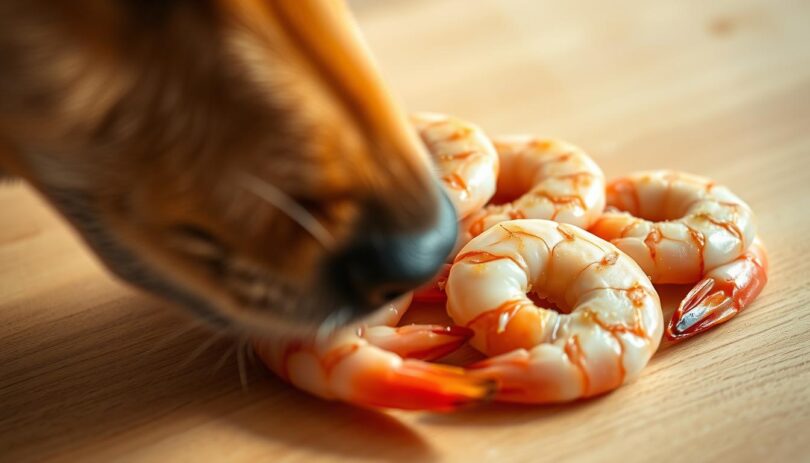As a pet owner, you might have wondered: Is shrimp safe for dogs? This question has sparked debate among pet enthusiasts and experts alike. While some believe shrimp can be a healthy treat, others caution against it. The truth lies in the details.
Shrimp is a nutrient-rich seafood option, packed with protein, vitamins, and omega-3 fatty acids. These nutrients can support your dog's overall health, from skin health to heart function. However, proper preparation is essential to ensure safety.
Experts have mixed opinions on feeding shrimp to dogs. While cooked shrimp can be a safe occasional treat, there are risks to consider. High cholesterol levels and potential bacterial hazards like Salmonella are concerns. Additionally, some dogs may develop allergies to shellfish.
In theory, dogs can eat cooked shrimp, but moderation is key. It's important to remove shells and tails to prevent choking hazards. Fried or raw shrimp should be avoided due to harmful pathogens and unhealthy ingredients.
Before adding shrimp to your dog's diet, consider both the benefits and risks. Nutritional value must be weighed against potential allergic reactions and digestive issues. Expert recommendations will guide you on making informed decisions for your pet's wellbeing.
Understanding Shrimp Nutrition for Dogs
Shrimp can be a nutrient-rich addition to your dog's diet when prepared correctly. This seafood treat offers several health benefits due to its high protein content and essential vitamins and minerals.
Nutritional Benefits and Protein Sources
Shrimp is low in calories and high in protein, making it an excellent occasional treat for dogs. The protein in shrimp supports muscle growth and muscle repair, which is essential for maintaining your dog's overall health.
Key Vitamins and Minerals in Shrimp
Shrimp is a good source of vitamin B12, which supports the nervous system and energy production. It also contains minerals like selenium and iron, which are important for immune function and overall health. Omega-3 fatty acids in shrimp help support skin and heart health, contributing to a shiny coat and reducing inflammation.
While shrimp offers these benefits, it shouldn't replace your dog's balanced diet. Portion control is crucial to avoid overfeeding and potential weight gain. Additionally, the nutritional content can vary depending on whether the shrimp is wild-caught or farm-raised. Always ensure shrimp is properly cooked and free of shells to minimize risks.
Can Dogs Eat Shrimp? The Essential Facts
Shrimp can be a safe and healthy treat for dogs when prepared properly. However, it's important to consider several factors before serving shrimp to your pet.
The Quick Answer and Key Considerations
Cooked shrimp can be a safe occasional treat for dogs. Shrimp is a nutrient-rich seafood option, packed with protein, vitamins, and omega-3 fatty acids. These nutrients can support your dog's overall health, from skin health to heart function. However, proper preparation is essential to ensure safety.
Expert Recommendations from Veterinarians
Veterinarians recommend feeding dogs only fully cooked and peeled shrimp. Shrimp shells and tails should be removed to prevent choking hazards. Raw or undercooked shrimp can pose health risks, including bacterial contamination and parasites.
While shrimp is a good source of protein and omega-3 fatty acids, it should not replace your dog's balanced diet. Portion control is crucial to avoid overfeeding and potential weight gain. Veterinarians also stress the importance of monitoring your dog for any signs of an allergic reaction, such as vomiting or diarrhea.
Before adding shrimp to your dog's diet, consult with your veterinarian to ensure it's a safe and suitable option for your pet.
Risks and Safety Concerns of Feeding Shrimp
While shrimp can be a nutritious treat for dogs, it's important to be aware of the potential risks. Proper preparation and cautious serving are key to ensuring your pet's safety.
Bacterial Contamination and Foodborne Illnesses
Raw or undercooked shrimp can harbor harmful bacteria like Salmonella, Vibrio, and Listeria. These pathogens can lead to serious foodborne illnesses in dogs, causing symptoms such as vomiting and diarrhea. Proper cooking is essential to eliminate these risks and keep your pet safe.
Potential Allergic Reactions and Digestive Blockages
Some dogs may develop allergies to shellfish, which can result in symptoms like itching, swelling, or even difficulty breathing. Additionally, shrimp shells and tails can pose a choking hazard or cause intestinal blockages, especially in smaller breeds. Always remove these parts before serving.
Hazards of Shrimp Shells and Tails
Shrimp shells and tails are not only choking hazards but can also cause digestive irritation or blockages. Even small amounts, if improperly prepared, can lead to serious health issues. It's crucial to ensure all hazardous parts are removed before feeding shrimp to your dog.
In summary, while shrimp can be a healthy treat, it's important to be mindful of the risks. Always cook shrimp thoroughly, remove shells and tails, and feed in moderation. Consult your veterinarian for personalized advice to keep your pet safe and healthy.
Proper Preparation and Serving Tips
Preparing shrimp for your pup requires careful steps to ensure safety and nutrition. This section will guide you through the best methods to cook and serve shrimp safely for your dog.
Cooking Techniques to Eliminate Pathogens
Cooking shrimp properly is essential to remove harmful bacteria like Salmonella. Boiling or steaming are the best methods as they avoid adding extra fat. Always cook shrimp until it's opaque and fully peeled to ensure food safety.
Avoid frying or adding seasonings, as these can cause health issues. Keep it plain to make sure your pup gets only the nutrients without any harmful additives.
Guidelines for Removing Shells and Deveining
Shells and tails must be removed to prevent choking or digestive problems. Deveining is also important to take out the dark vein, which can be gritty and cause issues.
After cooking, let the shrimp cool before serving. Serve only the flesh, and chop it into small pieces if needed. This makes it easier for your pup to eat safely.
Portion control is key. Small dogs can have 1-2 shrimp, medium dogs 2-3, and large dogs up to half a cup. Remember, shrimp should be an occasional treat, not a main meal.
Always check for any signs of an allergic reaction, like itching or vomiting. If you notice any, stop serving shrimp and consult your vet.
By following these steps, you can safely include shrimp as a healthy, tasty treat for your pup. Always put your dog's health first and seek expert advice if needed.
Healthy Alternatives to Shrimp for Your Dog
If your dog has an allergy or issue with shrimp, there are plenty of other nutritious options to consider. These alternatives can provide similar benefits without the potential risks associated with shrimp.
Other Seafood Options with Lower Risks
Sardines and salmon are excellent seafood choices for dogs. They are rich in omega-3 fatty acids, supporting skin and heart health, and have lower risks of allergies compared to shrimp. Green-lipped mussels are another great option, offering anti-inflammatory benefits.
Non-Seafood Treats to Consider
For dogs with severe allergies, non-seafood treats like sweet potatoes, green beans, and carrots are ideal. These options are easily digestible and packed with essential nutrients, making them perfect for sensitive pets.
Switching to these alternatives can help reduce dependency on a single protein source, promoting a varied diet. Always consult your veterinarian before making any significant changes to your dog's diet to ensure the best choices for their specific needs.
Portion Control and Frequency in a Balanced Diet
When it comes to treating your pooch to shrimp, moderation is key. Understanding the right portion sizes and how often to serve this seafood treat ensures a balanced diet for your furry friend.
Calculating Safe Treat Sizes for Different Breeds
Determining the perfect portion of shrimp for your dog involves considering their size, breed, and activity level. A small shrimp, roughly 10 calories, can be a great occasional treat. However, it's important to remember that treats should not exceed 10% of your dog's daily calorie intake.
For example, a 30-pound dog with a moderate activity level might have a daily caloric need of around 1,200 calories. This means shrimp treats should be limited to about 120 calories. Given that each small shrimp is 10 calories, your pooch could safely enjoy up to 12 shrimp pieces as an occasional treat.
Here are some general guidelines for portion control:
- Small breeds (under 20 pounds): 1-2 shrimp pieces per serving
- Medium breeds (20-50 pounds): 2-3 shrimp pieces per serving
- Large breeds (over 50 pounds): 3-4 shrimp pieces per serving
Remember, even healthy treats like shrimp, if given in excess, can lead to digestive issues or weight gain. Improper preparation can also introduce parasites, making moderation crucial.
Always measure portions carefully and consult your veterinarian to adjust based on your dog's specific health and activity level. This ensures your pooch enjoys the benefits of shrimp without any adverse effects.
Final Considerations for Safe Seafood Treats
When considering seafood treats like shrimp for your pet, it's essential to balance the benefits with the risks. Shrimp offers protein, omega-3 fatty acids, and vitamins, but improper preparation can lead to issues like bacterial contamination or allergic reactions. Always cook shrimp thoroughly, remove shells and tails, and serve in moderation.
Expert advice emphasizes proper preparation and portion control. Veterinarians recommend cooked, plain shrimp without seasonings. Monitor your pet for any signs of an allergic reaction, such as itching or vomiting, and consult your vet for personalized dietary advice.
For a safe and healthy approach, keep shrimp as an occasional treat. If concerns arise, explore alternatives like sardines or sweet potatoes. Always prioritize your pet's well-being by following these guidelines and seeking professional guidance when needed.









Leave a Comment